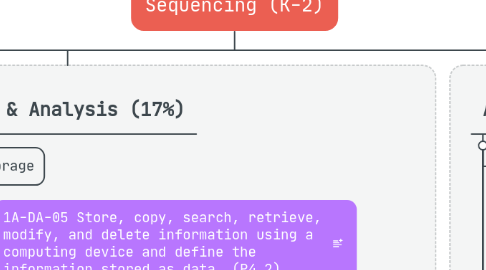
1. Computing Systems (17%)
1.1. Devices
1.1.1. 1A-CS-01 Select and operate appropriate software to perform a variety of tasks, and recognize that users have different needs and preferences for the technology they use. (P1.1)
1.2. Hardware & Software
1.2.1. 1A-CS-02 Use appropriate terminology in identifying and describing the function of common physical components of computing systems (hardware). (P7.2)
1.3. Troubleshooting
1.3.1. 1A-CS-03 Describe basic hardware and software problems using accurate terminology. (P6.2, P7.2)
2. Networks & the Internet (6%)
2.1. Network Communication & Organization
2.1.1. none
2.2. Cybersecurity
2.2.1. 1A-NI-04 Explain what passwords are and why we use them, and use strong passwords to protect devices and information from unauthorized access. (P7.3)
2.2.1.1. First (if on computers)
2.2.1.2. Second
3. Data & Analysis (17%)
3.1. Storage
3.1.1. 1A-DA-05 Store, copy, search, retrieve, modify, and delete information using a computing device and define the information stored as data. (P4.2)
3.2. Collection, Visualization, & Transformation
3.2.1. 1A-DA-06 Collect and present the same data in various visual formats. (P7.1, P4.4)
3.3. Inference & Models
3.3.1. 1A-DA-07 Identify and describe patterns in data visualizations, such as charts or graphs, to make predictions. (P4.1)
3.3.1.1. First
3.3.1.2. Second
4. Algorithms & Programming (44%)
4.1. Algorithms
4.1.1. 1A-AP-08 Model daily processes by creating and following algorithms (sets of step-by-step instructions) to complete tasks. (P4.4)
4.2. Variables
4.2.1. 1A-AP-09 Model the way programs store and manipulate data by using numbers or other symbols to represent information. (P4.4)
4.3. Control
4.3.1. 1A-AP-10 Develop programs with sequences and simple loops, to express ideas or address a problem. (P5.2)
4.3.1.1. Sequences
4.3.1.2. Loops
4.3.1.3. Loops
4.4. Modularity
4.4.1. 1A-AP-11 Decompose (break down) the steps needed to solve a problem into a precise sequence of instructions. (P3.2)
4.5. Program Development
4.5.1. 1A-AP-12 Develop plans that describe a program’s sequence of events, goals, and expected outcomes. (P5.1, P7.2)
4.5.2. 1A-AP-13 Give attribution when using the ideas and creations of others while developing programs. (P7.3)
4.5.3. 1A-AP-14 Debug (identify and fix) errors in an algorithm or program that includes sequences and simple loops. (P6.2)
4.5.4. 1A-AP-15 Using correct terminology, describe steps taken and choices made during the iterative process of program development. (P7.2)
5. Impacts of Computing (17%)
5.1. Culture
5.1.1. 1A-IC-16 Compare how people live and work before and after the implementation or adoption of new computing technology. (P7.0)
5.2. Social Interactions
5.2.1. 1A-IC-17 Work respectfully and responsibly with others online. (P2.1)
5.3. Safety, Law, & Ethics
5.3.1. 1A-IC-18 Keep login information private, and log off of devices appropriately. (P7.3)
5.3.1.1. First (if on computers)
5.3.1.2. Second
